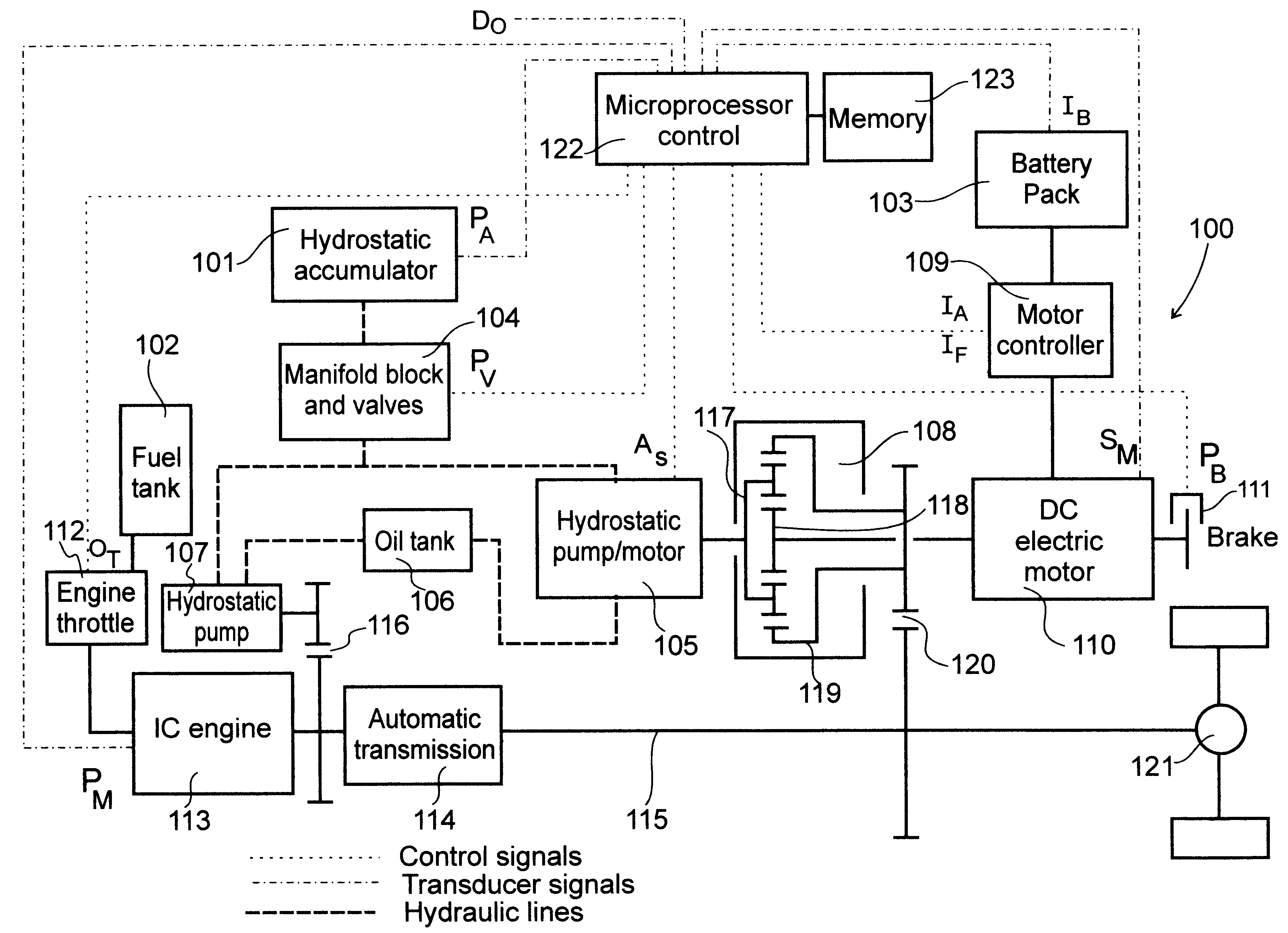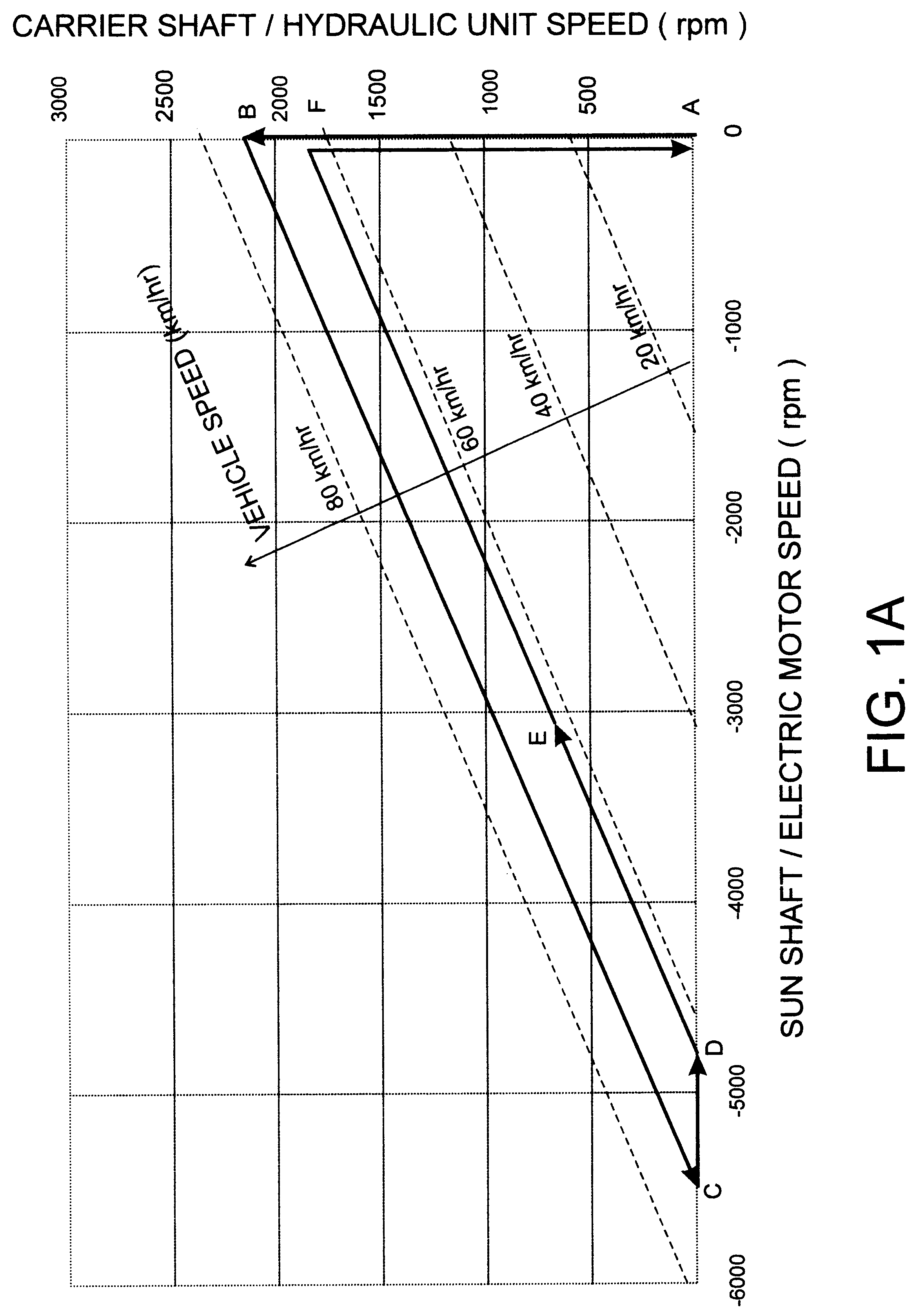Hybrid propulsion system for road vehicles
a hybrid propulsion and road vehicle technology, applied in mechanical hybrid vehicles, fluid hybrid vehicles, fluid gearings, etc., can solve the problems of high noise, high fuel consumption, environmental pollution, etc., and achieve the effect of maximising the efficiency of operation of each propulsion uni
- Summary
- Abstract
- Description
- Claims
- Application Information
AI Technical Summary
Benefits of technology
Problems solved by technology
Method used
Image
Examples
first embodiment
A first embodiment, which is an example of a hybrid propulsion system configured for non-transit omnibus operations in accordance with a first form of the invention, is represented by the block diagram shown in FIG. 2. The propulsion system 100 is particularly suited to relatively low range operations, due to the need to stop frequently in the case of city operations and also to the restricted hours of operation in morning and afternoon periods, in the case of school operations. The propulsion system includes three disparate energy storage means, namely a fluid pressure storage means in the form of a hydrostatic accumulator 101, a chemical energy storage means in the form of a fluid fuel tank 102, and an electrical energy storage means in the form of a battery pack 103.
The hydrostatic accumulator 101 is in a fluid hydraulic circuit with a fluid pressure control means in the form of manifold block and valves 104, a first hydraulic machine in the form of a hydrostatic pump / motor 105, ...
third embodiment
the invention, relating to another form of hybrid propulsion system configured for transit omnibus operations, is represented by the block diagram shown in FIG. 6. The propulsion system 300 is particularly suited to medium to high range operations, for example 200 to 400 km. The system may also be employed for suburban transit operations, perhaps as low as only 100 to 120 km. The propulsion system of the third embodiment again includes at least three different energy storage means.
A hydrostatic accumulator 301 is in a fluid hydraulic circuit with a fluid pressure control means in the form of manifold block and valves 305, a series of fluid pressure energy conversion means--including a first hydrostatic pump / motor 306, a second hydrostatic pump / motor 307 and a hydrostatic pump 308--and an oil tank 309. The first hydrostatic pump / motor 306 is coupled to a power splitting gearbox being a three shaft epicyclic gearbox 321, the second hydrostatic pump / motor 307 is coupled to a first gear...
fourth embodiment
FIG. 8 shows a hybrid propulsion system which shows certain modifications to the system of FIG. 6 and is particularly suited to high speed cruise operations, where it is important to substantially eliminate the losses associated with the second hydrostatic pump / motor 327. In this embodiment a modified gear set 328 is moved to the other side of the automatic transmission 314 from the IC engine 313, when compared to the first gear set 310 of the embodiment shown in FIG. 6. This is facilitated by the inclusion of a further gear for coupling the second hydrostatic pump / motor 327 and electric motor 317 to the tail shaft 315. The modified gear set 328 provides a gear ratio of 1.25:1 between the second hydrostatic machine 327 and the tail shaft 315 and, similarly, a gear ratio of 1.25:1 between the electric motor 317 and the second hydrostatic machine 327. This is a convenient arrangement when the speed changing transmission comprises an automatic gearbox and the losses associated with the...
PUM
 Login to View More
Login to View More Abstract
Description
Claims
Application Information
 Login to View More
Login to View More - R&D
- Intellectual Property
- Life Sciences
- Materials
- Tech Scout
- Unparalleled Data Quality
- Higher Quality Content
- 60% Fewer Hallucinations
Browse by: Latest US Patents, China's latest patents, Technical Efficacy Thesaurus, Application Domain, Technology Topic, Popular Technical Reports.
© 2025 PatSnap. All rights reserved.Legal|Privacy policy|Modern Slavery Act Transparency Statement|Sitemap|About US| Contact US: help@patsnap.com



